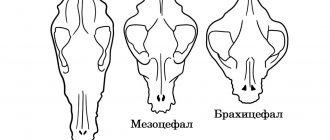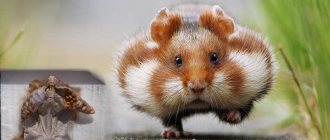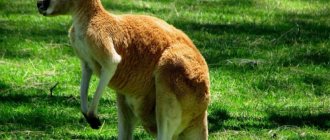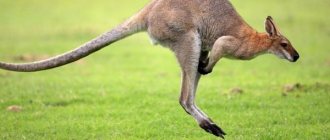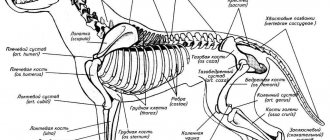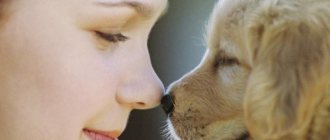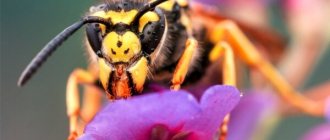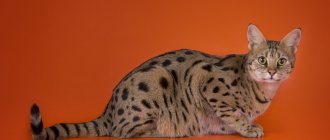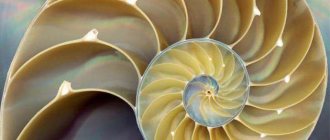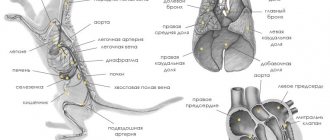The mustachioed pets captivated the ancient Egyptians with their grace and majesty, so they were revered for a long time on a par with the gods. But even now, people continue to clean out cat litter boxes and feed their pets at 6 am if they refuse to eat alone. In addition to love, the level of responsibility also increases.
The modern owner knows much more about the body of his cat than the inhabitants of Ancient Egypt, but is constantly learning something new. And this is not surprising! Some facts about anatomy are not only useful, but also so stunning that they are definitely worth sharing with your friends.
What is known about the cat skeleton
The skeleton of a cat contains from 230 to 250 bones
, such a gap is associated with structural features of different breeds. For example, a Siberian or Siamese cat will have more bones than a Persian cat. In addition, the number of bones is greatly influenced by the length of the tail.
Photo: Structure of a cat's skeleton with a description (in format:
) |
Dreamstime.com For example, the tail of the Kurilian Bobtail is actually in a rudimentary state, which means there are very few vertebrae in it, but the Brazilian Shorthair cat has a very long tail, which means there are a lot of bone vertebrae in it. By the way, if you compare cat and human skeletons, the animal will win
: It is believed that purrs have on average 30-45 more bones than their owners.
General information
What is the anatomy of a cat's skeleton? As mentioned above, the animal’s body is divided into regions. In the head there is a face and a skull. The latter contains the anterosuperior part, the crown, the back of the head, the forehead, and the temple. The face is distinguished by the intermaxillary, buccal, orbital, oral, buccal and nasal regions. The cat's neck runs from the back of the head to the shoulder blade. The body is divided into a chest with a corresponding cavity and a back. The mammary glands are located on the chest. The back is divided into two vertebral regions. One is thoracic, the second is interscapular. In the last one on the left, in the area of the elbow joint, there is a cardiac part. The abdomen is divided into posterior, middle and anterior regions. The first contains the inguinal and pubic segments. The abdomen passes into the pelvic region. It includes the ischial, gluteal and sacral parts. The limbs of the animal are divided into pelvic and thoracic. The cat's toes have retractable claws. The animal steps on the lower part - the pads.
Cat skull
Skeletal structure of a cat
Let's start with the skull, which consists of two sections:
the brain
, which contains 11 bones, and
the facial
, containing 13 bones. It is necessary to mention some features of the structure of the skull: large rounded eye sockets, straight or upturned short bridge of the nose (in brachycephalic breeds), wide (for example, in an exotic cat) or narrow cheekbones (for example, in an Oriental cat). It is impossible not to mention the cat’s jaws, in which sharp and small-sized teeth are “built in”; an adult animal should have 30 of them in total.
Brain and endocrine system
The brain is the central organ of the nervous system. It analyzes the signals received through the nerve endings and converts them into commands that it gives to the animal’s body. Although this organ makes up 1% of a cat's body weight, it uses about 20% of the blood pumped by the heart muscle.
The brain is made up of neurons. The two hemispheres are responsible for the animal's emotions, learning and behavior. The cerebellum is responsible for movement. The brain is attached to the peripheral nervous system via the brainstem. Cats do not rely entirely on instinct. They learn to interact with the outside world and other living beings. The cat's behavior can be corrected. Little kittens need socialization and constant contact with humans, otherwise they will become wild. At an older age, it will be much more difficult to accustom them.
Hormones play a major role in the functioning of a cat’s body. The hypothalamus produces antidiuretic hormone (affects the composition of urine), corticoliberin (thanks to this hormone, the adrenal glands secrete cortisol in response to danger), oxytocin (affects milk production, and also plays an important role during pregnancy and childbirth). The pituitary gland produces growth hormones.
The adrenal glands are an important part of the endocrine system. They secrete cortisol, which helps to respond to injuries in a timely manner. They also secrete epinephrine, this hormone regulates the heart rate, and the frequency of dilation of blood vessels also depends on it.
Spine of a cat
When discussing the skeleton of a cat, it is impossible not to mention the spine
- load-bearing and, perhaps, the most important element of the skeletal system.
The cat's spine includes the cervical, thoracic, lumbar, sacral and caudal sections. The cervical region
, which performs the important function of supporting and turning the head sideways and up and down, consists of 7 vertebrae.
The thoracic region
contains 13 vertebrae and 12 pairs of ribs, 8 of which are attached to the sternum, and the remaining 4 are considered false, not attached to the sternum bone.
Lumbar
The cat skeleton consists of 7 vertebrae, increasing from the thoracic to the sacral.
The high level of mobility of the lumbar region is explained by the attachment of elastic cartilage pads to the vertebrae. The sacrum
, which is not very mobile, consists of only 3 large bones, firmly attached to each other so that the cat can support the load while running and jumping.
Number of caudal vertebrae
, as we found out earlier, depends on the breed of the animal. The average number of vertebrae is about 20-25. A full, strong tail is a kind of steering wheel for a cat when falling and walking, allowing it to successfully balance. This is why cats that are usually short-tailed or completely tailless are more clumsy than their long-tailed counterparts. In addition, it is the tail that is the litmus test of a cat’s mood (every cat lover has noticed how furiously pets hit the floor with their tail during aggression or, for example, press it to their hind legs when scared).
Anatomical features
Dog skeleton: skull anatomy, structure of ribs and internal organs
The cat is the perfection of nature. She has no equal in the variety of physical capabilities. Cats masterfully jump, climb, balance, run, and react with lightning speed to danger. The most important part of a cat's body is its internal organs. The relationship between the nervous system and muscle performance makes the pet an excellent hunter.
Digestive system
The digestive system consists of organs responsible for processing food. Food enters the mouth and passes through the esophagus, stomach, small and large intestines before passing through the anus as solid waste.
The digestive system is structured almost the same as in humans
The system includes:
- mouth;
- teeth;
- language;
- salivary glands;
- esophagus;
- stomach;
- mucous membranes of the stomach;
- small intestine;
- large intestine;
- pancreas;
- liver;
- gallbladder.
Digestion of food occurs in 2 stages:
- mechanical. Food is crushed by teeth;
- chemical. Food is broken down into nutrients, which are absorbed into the blood through the walls of the small intestine.
Sense organs
The animal body has five sense organs: visual, equilibrium-auditory, olfactory, gustatory and tactile. Each of these bodies has departments:
- peripheral (perceiving) - receptor;
- middle (conductive) - conductor;
- analyzing (in the cerebral cortex) - brain center.
A cat's senses are a miracle of nature.
Features of the senses:
- the shape of the ears allows the cat to direct sound into the funnel. The ear tubes are lined with fine hairs that pick up sound vibrations;
- the sharpness of taste depends on the Jacobson's tube, which is also an organ of smell, which allows the animal to avoid accidental poisoning;
- cats have a very good sense of smell as they have 70 million olfactory cells inside their nose. Every contact with another living creature involves preliminary sniffing;
- Cats have a very well developed sense of touch. Most of the skin surface does not feel contact with hot surfaces at all, but the upper lip and nose are very sensitive. They receive signals and information from even the slightest air fluctuations;
- the animal moves its whiskers due to the presence of short small muscles located at the very roots.
Pets have vision, hearing, smell, touch and taste. This allows them to recognize smells, hear noises over long distances, and see in the dark.
Circulatory system
An important organ of the circulatory system is the heart, which is a muscle weighing 0.6% of the animal’s weight. It drives blood through two circles of blood circulation. Moving through the arteries and capillaries, the blood is saturated with the products of cellular activity and carbon dioxide, enters the veins and is sent through the heart through the second (lesser) circulation.
For your information! A 4 kg cat has approximately 0.2 liters of blood. Its composition and characteristics are still poorly studied. Veterinary medicine has described cases where a cat was not affected by doses of snake venom, even many times greater than lethal doses for other living beings.
Reproductive system
The reproductive system of cats is a set of organs and processes in the body aimed at the reproduction of offspring. It develops over a long period of time and varies by gender. The internal structure of a cat differs from the structure of a cat in its reproductive system. Outwardly, this manifests itself in the fact that in cats the scrotum is located just below the anus, in cats there is a slit-like vagina (vulva) in this place. Cats reach sexual maturity at 6-8 months. This means that the animal reaches physiological maturity and can be used for reproduction.
Depending on the breed, maturity appears at the age of 10 months to 1.5 years. To get full-fledged offspring, mating can only be done from this age of the pet. X-rays are used as an additional measure to monitor late pregnancy in cats.
Nervous system
The internal organs of cats are located in the same way as those of other mammals, have almost the same structure and perform similar functions.
The nervous system is responsible for transmitting messages to and from the brain and spinal cord. The spinal column is protected by bony dorsal vertebrae.
The nervous system is structured the same as that of all other mammals
The nervous system is divided into two parts:
- central. Consists of the brain and spinal cord, which are protected by a bony membrane: the skull (brain) and the spine (spinal cord);
- peripheral. Consists of nerves that connect the central nervous system with other parts.
The nervous system of cats, both central and peripheral, is well developed and functions properly. Activity is carried out using the senses: hearing, vision, smell, taste and touch. Fully develops as the kitten matures.
Respiratory system
The anatomy of a cat is not much different from other mammals. This also applies to the respiratory system, which is responsible for bringing oxygen into the body and removing waste in the form of carbon dioxide.
The system includes:
- nose;
- pharynx;
- larynx;
- trachea;
- bronchi (small airways);
- lungs.
The lungs have the shape of a truncated cone, the apex of which is located in the area of the first ribs, and the base is concave and corresponds to the dome of the diaphragm.
Brain and endocrine system
The brain is a mass of soft, pinkish-gray nervous tissue divided into three main sections:
- brain stem;
- brain;
- cerebellum.
A cat's brain consists of a billion neuron cells, and each cell has up to 10 thousand connections with other cells. The brain occupies 0.9% of the total body weight.
The brain occupies 0.9% of the total body weight
The endocrine system is responsible for the endocrine gland to regulate the body. It includes:
- hypothalamus;
- pituitary;
- thyroid gland;
- parathyroid glands;
- adrenal glands;
- part of the gastrointestinal tract;
- pancreas;
- kidneys;
- liver;
- ovaries and testes.
The endocrine system is distributed throughout the body as follows:
- the hypothalamus is located at the base of the brain;
- The pituitary gland is located at the base of the brain and is attached to the hypothalamus through a stalk-shaped cartilage;
- The thyroid gland is located in the neck below the larynx (voice box);
- there are two parathyroid glands located in the neck, closely related to the thyroid gland;
- there are two adrenal glands located in the abdominal cavity just in front of the kidneys;
- the gastrointestinal tract (GIT) is located in the abdominal cavity;
- pancreas in the front of the abdominal cavity, behind the liver and stomach;
- the liver is located in the front of the abdomen just behind the diaphragm;
- the ovaries are located in the middle part of the abdominal cavity next to the kidneys;
- The testicles are placed in the scrotum.
Leather and wool
Skin and hair cover the cat's entire body. The skin protects the muscles, skeleton and internal organs. Hair is located on the outer part of the skin.
Skin consists of:
- outer cellular layer;
- an avascular layer called the epidermis;
- inner fibrous corium, or dermis.
The epidermis is the body's shield. It consists of hard, keratinized cells. The dermis is made up of connective tissue that contains nerves, blood vessels, hair follicles, sweat and oil glands.
From each follicle in cats, two types of hairs grow: covert (awn) and secondary - downy.
A cat has four different types of hairs:
- The undercoat is the hairs closest to the skin. Their diameter does not change from root to tip. The main function is to protect the body from cold;
- guard hairs form the middle layer of the coat. They are bristly with a slight expansion in front of the tip;
- The protective coat forms the top coat and protects the undercoat and midcoat from external influences. It tapers evenly from root to tip;
- vibris - long, stiff and sensitive hairs that are used as organs of touch. These are mustaches, hair on the cheeks, chin, eyes and on the wrists of the front paws.
The camouflage function is manifested in the variety of shades of wool.
For your information! The sebaceous glands secrete fat rich in vitamin D.
Cat reproductive system
The reproductive system is an organ system designed for reproduction.
How does the genitourinary system work?
This system in a cat includes:
- the ovaries are responsible for childbirth by producing follicles;
- the tubes serve as a place for fertilization of the egg, creating a favorable environment for this;
- vulva is a general term that refers to all female genital organs located externally;
- The uterus is created for the development of the embryo and its birth.
Occurring ovulation provokes the cat to mate.
Anatomy of the cat's reproductive system
In cats, two testes (testicles) are located in the scrotum, which is located below the anus. The testes produce sperm, which pass through a system of efferent tubules into the epididymis (epididymis), where they are stored.
The cat managed to preserve the behavior pattern inherent in its wild ancestors; it hunts almost as well. The skeleton, muscles and nerves are designed for sudden sharp movements and jumps, an ideal sense of balance allows her to climb high and live in three dimensions. The digestive system is capable of digesting food, and the secretions are used to communicate with other cats. Thanks to the structure of the brain, a cat is able to learn throughout her life, and her unique senses help her in this.
Skeletal forelimbs
shoulder blades follow the neck
, which the cat, when moving, either raises or lowers simultaneously with its limbs. But cats have practically no collarbones, or rather, they are in their infancy in cats. Such miniature collarbones allow animals to smoothly lower to their paws even from a considerable height (there are cases when cats successfully landed when falling from the 32nd (!) floor), and also climb through even the most modest-sized openings: cracks in the fence, half-open windows, door openings, etc.).
From the scapula, the cat's forelimbs consist of the humerus
,
forearm
(consists of the ulna and radius bones),
hand
(consists of the wrist, metacarpus and 5 phalanges of the fingers). It is worth noting that, unlike the hind limbs, the cat's forelimbs are relatively short and weak.
Digestive and excretory systems
Food enters the cat's stomach through the esophagus. The walls of the esophagus are covered with muscles. They make wave-like movements and push food into the stomach. The stomach of cats is quite spacious. The inside is covered with folds that help chop and digest food. The walls of the stomach secrete acid, which is very important for digestion. Processed food enters the duodenum through the pyloric sphincter.
The duodenum is the first section of the small intestine. The liver and pancreas secrete enzymes that are mixed with food in the duodenum. Next, the food enters the jejunum. It is covered with villi, which are needed to extract all remaining nutrients from food. Next, the food enters the ileum, and then into the large intestine.
The large intestine absorbs fluid from stool. In addition, the large intestine serves to store feces until the animal is ready to defecate. The large intestine consists of the following sections: cecum, colon and rectum.
Excess fluid is removed from the cat’s body through the work of the bladder, ureters and kidneys. In addition, the water-salt balance of the body depends on these organs. Urine is formed in the kidneys and passes through the ureters to the bladder.
A cat is able to control urination thanks to the closing muscle, which retains fluid in the body. Urine exits through the urethra, which in cats ends at the head of the penis, and in cats in the vagina.
Hind limbs of the skeleton
When it comes to the structure of a cat's skeleton, it is important to pay special attention to the hind limbs, which consist of the pelvis
(right and left innominate bones),
thigh
(consists of the femur and patella),
lower leg
(includes the fibula and tibia) and
foot
(it includes the tarsus, metatarsus and 4 phalanges of the fingers). By the way, some cats may have 5 toe phalanges on their hind legs.
The hind limbs of the cat are powerful, moderately long and excellently developed. They allow the cat to climb trees and jump high without any problems. It is believed that on average a cat can jump to a height that is 5 times its height.
.
Also, the massive hind limbs allow the mustachioed pets to run quickly. In case of danger, cats can reach speeds of about 45 kilometers per hour
. For comparison: only some sprinters can reach this speed, but the average person can run at a speed of only 15 (maximum 20) kilometers per hour. But a cat can outperform even any fast runner, because a person can only walk or run on a horizontal surface, while a cat can overcome vertical obstacles.
Navigating in space
Finally, it is worth mentioning what a cat’s sense organs are made of. This includes not only the eyes, ears and nose, but also the tongue and whiskers.
The vision of a genius
Whiskered pets see perfectly in the dark, distinguish 3 colors (red, blue, green) and as many as 25 shades of gray. The mysterious glow of their huge eyes at night is explained by the tapetum - a special vascular layer located behind the retina.
Thanks to the convex cornea, the viewing angle of these animals is almost 270°, so with the help of their necks they are able to assess the situation at all 360°.
Whiskers
The tactile function is performed by vibrissae, that is, cat whiskers. In fact, they also belong to hairs, but their follicles lie much deeper than the guard coat and undercoat. They actively interact with nerve impulses, determining the surrounding temperature, perceiving signals of pain and pleasant touches.
These tactile hairs are found not only on the face, but also on the hind legs. Because of this, mustachioed pets actively shake them when they step in the mud or enter the water.
Pulling or cutting mustaches is strictly prohibited. In addition to acute pain, the animal may permanently lose its tactile function, which will affect orientation in space and mental health.
Nose-sniffer
The cat's nose contains 80 million olfactory receptors, so its sensitivity is 2 times higher than that of humans. Additionally, the Jacobson's organ, a small tube located on the upper palate, is responsible for the perception of odors.
Another interesting fact is that the imprint of a wet cat’s nose, like the pads of human fingers, is unique. Thanks to this, it can easily be classified as biometric data.
Ears-on-top
The developed hearing of furry pets even detects ultrasound. Its ears, consisting of an outer, middle and inner part, are responsible for this. The task of the first is to collect sound, the second is to transmit a sound signal, and the third is to convert sound vibrations into nerve impulses.
Thanks to this feature, animals moving to the dacha in the summer can easily find their way back during their walks. Having moved away 3 km, they perfectly hear the voices of their owners and other sounds associated with a country house.
Tongue - lover of food
Despite night vision, an excellent sense of smell and acute hearing, cats are inferior to us in some ways. The tongue has only 473 taste buds, while the human tongue has as many as 9,000.
Whiskered pets are good at distinguishing sour, salty and bitter foods, but almost unable to detect sweet ones. The love for ice cream is explained by its similarity to milk, familiar from childhood. For this reason, treats should be avoided as animals become lactose intolerant as adults.
Separately, it is worth noting 2 special receptors that are not typical for humans. One recognizes the taste of umami, that is, monosodium glutamate, and the second recognizes the taste of water. This is why cats often steal sausages and have a special love for unstagnant tap water.
Prevention of bone diseases in cats
- Reasonable physical activity.
Bone tissue is strong in those cats that live an active life, but couch potato animals have brittle bones; - Consumption of foods rich in calcium
(milk, parsley and green vegetables, sea fish, buckwheat, some wheat bran); - Taking foods containing vitamin D
(sea fish, chicken and beef liver, egg yolk, fermented milk products), or supplements with this vitamin. Plus frequent or at least periodic exposure to the sun; - Eliminating salt from the cat's menu.
In fact, every product that ends up in a cat’s bowl already contains a sufficient amount of sodium chloride, and therefore there is no need to add additional salt to the food. This white crystalline food additive makes bones fragile, and also harms kidney function, negatively affects the blood vessels and heart of cats, promotes weight gain and retention, and damages vision; - Controlling your cat's weight.
The more a cat weighs, the harder it is on its skeleton. An obese pet should be put on a low-calorie diet, but only after consulting a veterinarian, who will identify the cause of excess weight gain (often obesity in mustachioed pets is not due to overeating, but due to hormonal disorders caused by a malfunction of the pancreas or thyroid glands. which will require the use of medications); - Seek immediate medical attention in case of injury.
Unfortunately, our pets are not immune from accidents: an unsuccessful fall from a height (yes, cats do not always land successfully when falling), a fight with dogs, a collision with a car or bicycle, and so on. The same untreated crack in the bone is fraught with many complications: a fracture of the bone or its improper fusion, deformation of the damaged part of the skeleton, which will certainly negatively affect the quality of the animal’s motor activity.
Deviations in the internal and external structure of cats
Sometimes kittens are born with anomalies of external or internal structure. The reason is disturbances in intrauterine development (for example, due to exposure to toxins on the embryo) or genetic failures. There are thousands of types of deviations; it is impossible to list them all in one article. Here are the most common:
- Polydactyly is a pathology in which a kitten is born with 6 or more toes. There are cases of oligodactyly, when one or more fingers are missing.
- Micromelia - the front legs are too short, the pathology is also called “kangaroo disease”.
- Syndrome of flattened chest, in which it is 3–5 times shorter than normal in length (but wider). The pathology is dangerous because it interferes with the cat’s breathing.
- Transposition of the heart is the location of the organ on the wrong side. As a rule, this pathology is not accompanied by any complications and does not in any way affect the cat’s well-being.
- Pituitary dwarfism is a delay in growth and physical development caused by underdevelopment of the organs of the endocrine system and, as a consequence, insufficiency of produced hormones.
- Hip dysplasia is underdevelopment of the joints, which leads to shortened paws and their weakness (the animal constantly limps and is prone to dislocations and fractures).
- Megaesophagus is a pathology of the digestive system in which a kitten is born with an enlarged esophagus.
- Neuroaxonal dystrophy is an anomaly of the nervous system associated with underdevelopment of the brain.
An example of polydactyly is a cat with 7 toes on its front paws, whereas normally there should be 5
Important: many deviations in the external structure that arose unintentionally (without human participation) are initially considered deviations, but later become the basis for a new breed and are recognized as the norm. Example: curled ears, lack of tail or fur, too short legs or body, etc.
A cat is an animal with an interesting internal and external structure. It has something in common with human physiology and anatomy, but there are still more differences. The entire structure of its body is the result of evolution: nature has endowed the animal with the ability to hunt, run quickly, nimbly climb, jump high and easily adapt to changing conditions.
How to protect your pet from bone problems
The skeleton of cats and dogs begins to form in the second and last third of the mother's pregnancy, and continues to develop until the animal reaches puberty. But even after this, the skeleton does not remain constant; many factors can influence the bones.
That is why caring for your pet’s skeleton begins with proper and complete feeding of the mother. A growing body requires sufficient amounts of calcium and phosphorus in the diet. In this case, there should be more calcium than phosphorus. With an excess of phosphorus and a lack of calcium, the latter is washed out of the bone tissue and the “butcher’s dog effect” or hyperparathyroidism is observed. Excess calcium will also not be beneficial; it contributes to disturbances in the formation of cartilage.
It should be remembered that calcium is absorbed only in the presence of vitamin D. As is known, the body produces it under the influence of ultraviolet radiation. But an excess of vitamin can be very dangerous - it leads to kidney damage and digestive disorders.
Thus, an animal of any age needs a balanced diet that meets the body’s needs.
But there are other factors that influence the formation of the skeleton. Thus, early castration stops the production of sex hormones, which can cause bone underdevelopment. Long-term use of diuretics, corticosteroids, or antibiotics leads to bone loss of calcium, interruption of vitamin K production, and demineralization of bones.
Heart
The heart is the main organ in the circulatory system. It is formed by muscle tissue and has four chambers: two atria and two ventricles. The average weight of a cat's heart is about six-tenths of a percent of the animal's total body weight. A cat has two circuits of blood circulation:
- Big. Arteries carry blood to all organs and tissues of the body. They are entangled in a network of capillaries through which metabolism occurs. Veins return blood to the heart.
- Small. The pulmonary artery moves blood to the alveoli of the lungs. There it is saturated with oxygen and sent through the pulmonary vein back to the heart.
Blood
The bulk of blood is a clear, yellowish liquid called plasma. It is she who transports all substances throughout the body. Its volume is replenished by fluid absorbed in the large intestine.
Thirty to forty-five percent of the blood is made up of red cells (corpuscles) - erythrocytes. Their function is to transport oxygen.
Blood also contains leukocytes (white blood cells) and platelets. The former serve to protect against various microorganisms and toxic substances. The second ones are responsible for blood clotting.
There are only three blood types in cats:
- A (most common);
- B;
- AB (rare).
The important role of the shoulder joints
Another important factor in the flexibility of the animal is the peculiarity of the attachment of the shoulder blades. This bone is attached to the rest of the body solely with the help of muscles.
In a human or dog, on the other hand, the shoulder blades are part of the connecting joint that connects the shoulder and upper limb (arm in a person or front leg in a dog) to the body.
The different physiology of the scapula from humans allows cats to extend their stride even further when running. Their loosely attached shoulder blades, along with small, vestigial clavicles, allow the animal to squeeze into tiny and narrow spaces.
The next time you see a cat in some crazy, contorted position, or when the animal squirms out of your hands like a crazy snake, don't forget to thank the cat's spine and shoulders for allowing you to do such things.
general characteristics
These predators carry their young for about 2 months, feed them milk and sometimes show amazing care for their offspring.
There are many books and manuals on the maintenance, care, and nutrition of our pets. There are many more such books regarding dogs, which is associated with the development of service dog breeding. One of the best works on the anatomy and physiology of dogs (K. S. Stogov) is contained in all instructions for the training and education of service dogs.
Cats didn’t become service cats, but that doesn’t make people love them any less. Existing atlases of anatomy and physiology in pictures of dogs and cats provide a complete understanding of the similarities of these animals.
Annual life cycle
The life of rabbits is conventionally divided into certain stages:
- Embryonic development - from conception with the formation of the body to birth; lasts about a month.
- Childhood - from birth to the onset of puberty (up to about 3 months).
- Maturity occurs with the onset of puberty (depending on breed and physiology) and lasts up to 5-6 years. This is the main time for the animal to fully mature with the ability to reproduce.
- Old age occurs after the loss of reproductive properties and continues until the death of the animal (about 1-3 years).
Summing up the above information, we can say with confidence that rabbits are very developed animals, the structure of which is very similar in structure to most mammals on the planet. But in order for breeding eared pets to be beneficial and enjoyable, you need to know their physiological characteristics. Only by taking into account all the nuances will it be possible to properly organize life and create comfort for the animals.
